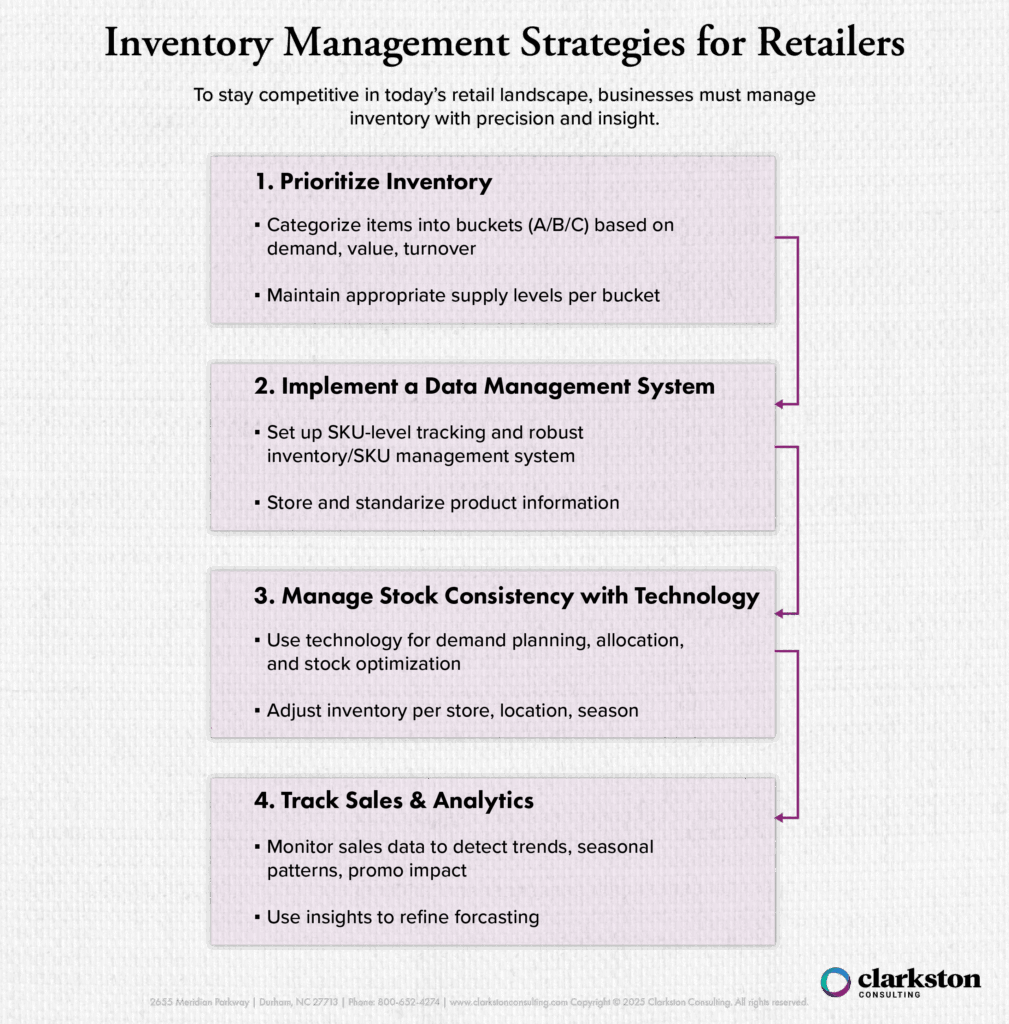4 Inventory Management Strategies for Retailers
Efficient inventory management stands at the heart of business profitability, yet many retailers grapple with the challenge of creating the right strategy. Ineffective management, whether through insufficient stock or excessive holdings, can lead to customer dissatisfaction with the selection of products available, cash flow issues, and outdated inventory resulting in lower margin goods. Below, our experts illustrate four key inventory management strategies for retailers to enhance their bottom line.
4 Inventory Management Strategies for Retailers
1. Prioritize Your Inventory
Categorizing inventory into priority buckets is a fundamental aspect of effective inventory management and control. This process involves classifying items based on their importance, demand, customer reviews, and other relevant factors. By using this “bucket” system, businesses can ensure popular and essential products are readily available. This will, in turn, reduce wait times for customers and streamline the checkout process.
Having a proactive approach to inventory management prevents delays in order fulfillment and minimizes the likelihood of customers encountering out-of-stock items when making purchases. Businesses can make informed, strategic decisions by analyzing historical sales data and market trends to identify which products are consistently in demand and which ones are declining in demand. Based on this analysis, retailers can adjust their production schedules and allocate resources to focus on the most profitable product lines, thus maximizing their overall performance and profitability. Below is an example of how a retailer might categorize their inventory:
Bucket A: High-ticket items that require strategic purchasing, with a focus on maintaining around 6 weeks of supply, aligning with typical purchase order timelines.
Bucket B: Middle-of-the-road items that require a balance between pricing and velocity, usually maintaining 10-12 weeks of supply based on product category and seasonality.
Bucket C: Lower-cost items with quick turnover benefit from small buys, aiming to sell within 5-6 weeks.
Prioritizing and “bucketing” inventory can lead to lower inventory turnover, streamlined order fulfillment, and better accuracy with demand forecasting. Combined, these can lead the business to achieve greater customer satisfaction and profit. After all, satisfied customers are more likely to make repeat purchases and become brand advocates, contributing to long-term profitability and success.
2. Implement a Data Management System
Consistent data maintenance and a robust inventory, or SKU (Stock Keeping Unit), management system is paramount for efficient inventory management. Retailers may struggle to keep up with stock, market trends, and inventory without a robust system in place.
Clarkston is currently working with a leading retailer after the client identified an over-inventoried store fleet and delayed allocation model. Based on Clarkston’s knowledge and steward experiences, implementing an inventory management system is the optimal solution. This will allow the client to accurately allocate inventory, driven by sales needs, in an expediated manner, which balances store fleet inventory and decreases most inventory transfer expenses, ensuring the client will be able to keep up with demand and market needs.
Other benefits can include:
- Because reliable data is important for making decisions in different sectors of the supply chain, from procurement to distribution, having a solid data management system ensures the accuracy and integrity of product information.
- A reliable SKU management system enables businesses to analyze historical data by week, month, and quarter; market trends; and customer behavior and spending habits. Having this information allows retailers to produce more accurate demand forecasts.
- Utilizing this optimization, businesses can better manage inventory turnover by identifying slow-moving items and making markdowns accordingly; tracking stock levels efficiently; and avoiding tying up capital with stagnant inventory.
- By ensuring consistent and accurate product information is available, customers can rely on the information provided and trust that the products they desire are in fact in stock. This leads to a more positive customer experience and builds brand loyalty.
- A reliable SKU management system makes sure store shelves can be stocked accurately based on real-time inventory data, minimizing the risk of stockouts and ensuring a well-organized and customer-friendly shopping environment.
- A good data management system aids in supporting accurate and well-maintained data, transparency among inventory planners and stores, and accountability surrounding sales. These are all essential for regulatory compliance and internal reporting as they play into the retailer’s stock and revenue.
All that said, maintaining consistent data and leveraging a robust inventory management system are critical for smooth operations, while a well-crafted strategy is key to achieving success and maintaining accurate, reliable, and functional data.
3. Manage Stock Consistency with Technology
The connection between stock consistency and demand planning is another important aspect of efficient business operations, and technology plays a pivotal role in facilitating this connection. Leveraging innovative technologies enhances the efficiency of businesses in adapting to market conditions and meeting customer demands effectively.
For instance, technological innovations can help with data integration and analysis. Maintaining consistent stock levels allows retailers to meet customer demand while avoiding overstock or stockouts. Technology also enables the use of sophisticated forecasting models that consider a range of factors, such as seasonality and promotions like buy-on-get-one (BOGO) deals and store-specific doorbusters. Above all, technology-driven inventory optimization systems help businesses determine the optimal stock levels to reduce holding costs while ensuring product availability. For example, the inventory sent to stores in Florida and North Dakota in February would not be the same due to weather differences and customer needs. By using inventory optimization, this allows retailers to sell most products given their location, time of year, and needs by consumer. This strategic approach not only meets customer demands successfully but also adapts to market conditions.
4. Track Sales and Analytics
Tracking sales data on a daily, weekly, and monthly basis is necessary for retail businesses. The practice of weekly business reviews, for example, allows retailers to keep sight of the performance of each product by store. By tracking this information, it provides valuable insight into the customer’s behavior with spending and overall business health. In doing so, retailers can get a better look into:
Trends
Weekly sales data help to identify trends and patterns over a short-term period. This allows businesses to assess the impact of promotions, marketing campaigns, or external events on sales. Recognizing weekly trends also provides insight into customer behavior and preferences, aiding in strategic decision-making.
Seasonal Variations
Monthly sales data provides a broader view, allowing businesses to observe seasonal variations and long-term trends. Understanding monthly sales patterns also aids in inventory planning and financial forecasting. Due to seasonal variations, stores in different geographical locations are allotted different assortments of products, which allows for capitalization on localization opportunities.
Customer Behavior
Analyzing sales data across different time periods also provides insight into customer behavior. Daily data can reveal impulsive buying patterns, while weekly and monthly data may highlight purchasing trends and cycles.
Promotional Effectiveness
Tracking sales data allows businesses to evaluate the success of promotional activities. By comparing sales performance during and after promotions, businesses can assess the effectiveness of discounts, loyalty programs, or other marketing initiatives such as in-store signage or promotional emails.
Analyzing sales data over different time periods reveals customer purchasing patterns and allows for promotional activity adjustments, and consistent monitoring empowers businesses to truly optimize their inventory.
Getting Started with Inventory Management
As businesses grow, the adoption of inventory management technologies becomes the foundation for success. The ability to optimize stock levels and forecast demand not only ensures cost efficiency but also positions businesses to be agile in the competitive market landscape. Investment in inventory management is an investment in the sustainability and competitiveness of a growing business. Here at Clarkston, our team of retail experts can help by assessing your current needs, from walking you through the vendor selection process to implementing your new technology to ensuring you get the most from it. Talk to one of our experts today to get started on your inventory management assessment.




